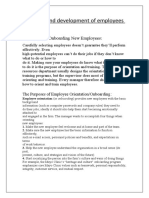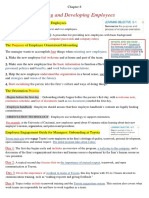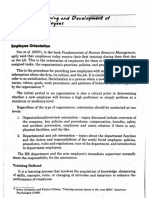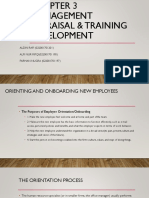0% found this document useful (0 votes)
135 views16 pagesLecture 07 Training and Development
Employee orientation and training are important to ensure new employees can perform effectively. Orientation involves making employees feel welcome, providing basic information to function, helping them understand the organization, and socializing them to the company culture. It is usually conducted by HR and department supervisors. Training provides employees with job-specific skills and should be aligned with business strategy. The training process involves needs analysis, instruction design, implementation, and evaluation. Motivation and making the learning meaningful and skills transferable are important for effective training.
Uploaded by
8 . zarin tabassumCopyright
© © All Rights Reserved
We take content rights seriously. If you suspect this is your content, claim it here.
Available Formats
Download as DOCX, PDF, TXT or read online on Scribd
0% found this document useful (0 votes)
135 views16 pagesLecture 07 Training and Development
Employee orientation and training are important to ensure new employees can perform effectively. Orientation involves making employees feel welcome, providing basic information to function, helping them understand the organization, and socializing them to the company culture. It is usually conducted by HR and department supervisors. Training provides employees with job-specific skills and should be aligned with business strategy. The training process involves needs analysis, instruction design, implementation, and evaluation. Motivation and making the learning meaningful and skills transferable are important for effective training.
Uploaded by
8 . zarin tabassumCopyright
© © All Rights Reserved
We take content rights seriously. If you suspect this is your content, claim it here.
Available Formats
Download as DOCX, PDF, TXT or read online on Scribd
/ 16
























































































